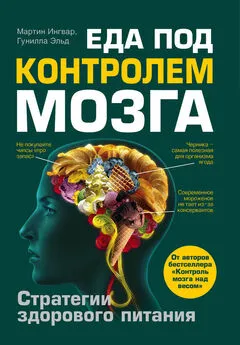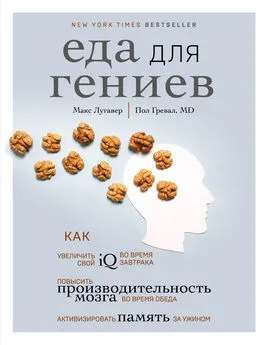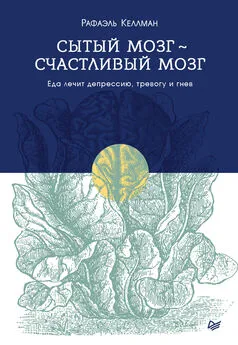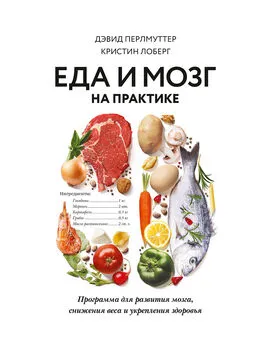Мартин Ингвар - Еда под контролем мозга
- Название:Еда под контролем мозга
- Автор:
- Жанр:
- Издательство:Array Литагент «5 редакция»
- Год:2012
- Город:М.
- ISBN:978-5-699-54470-7
- Рейтинг:
- Избранное:Добавить в избранное
-
Отзывы:
-
Ваша оценка:
Мартин Ингвар - Еда под контролем мозга краткое содержание
Еда под контролем мозга - читать онлайн бесплатно полную версию (весь текст целиком)
Интервал:
Закладка:
• Самые соблазнительные вкусности убирайте подальше в шкаф.
• Не покупайте низкокалорийные продукты, потому что они заставляют вас есть больше обычного и содержат много сахара и консервантов.
• После первой порции отодвиньте стул на 20 см от стола, чтобы до еды было сложнее дотянуться, не привлекая к себе внимания.
• Ешьте только за столом. Это касается всех приемов пищи.
Библиография
Aberg, M. A. et al. (2009), Fish intake of Swedish male adolescents is a predictor of cognitive performance . Acta Paediatr 98:555–560.
Abid, A. et al. (2009), Soft drink consumption is associated with fatty liver disease independent of metabolic syndrome . J. Hepatol 51:918–924.
Andres-Lacueva, C. et al. (2005), Anthocyanins in aged blueberry-fed rats are found centrally and may enhance memory . Nutr. Neurosci 8:111–120.
Anton, S. D. et al. (2010), Effects of stevia, aspartame, and sucrose on food intake, satiety, and postprandial glucose and insulin levels . Appetite 55:37–43.
Barber, N. J. & Barber, J. (2002), Lycopene and prostate cancer. Prostate Cancer Prostatic Dis. 5:6-12.
Barth, J. et al. (2010), Lack of social support in the etiology and the prognosis of coronary heart disease: a systematic review and metaanalysis . Psychosom Med. 72:229–238.
Bledina (2010) http://www.bledina.com
Broekaert, I. J. & Walker, W. A. (2006a), Probiotics and chronic disease . J. Clin. Gastroenterol 40:270–274.
Broekaert, I. J. & Walker, W. A. (2006b), Probiotics as flourishing benefactors for the human body . Gastroenterol Nurs. 29:26–34.
Brox, J. et al. (2002), Blood lipids, fatty acids, diet and lifestyle parameters in adolescents from a region in northern Norway with a high mortality from coronary heart disease . Eur J. Clin. Nutr. 56:694–700.
Buren, J. et al. (2003), In vitro reversal of hyperglycemia normalizes insulin action in fat cells from type 2 diabetes patients: is cellular insulin resistance caused by glucotoxicity in vivo? Metabolism 52:239–245.
Buyken, A. E. et al. (2007), Breakfast glycemic index affects subsequent daily energy intake in free-living healthy children . Am. J. Clin. Nutr. 86:980–987.
Chandon, P. & Wansink, B. (2007), The biasing health halos of fast food restaurant health claims: lower calorie estimates and higher sidedish consumption intentions. J. Consum Res. 34:301–314.
Christakis, N. A. & Fowler, J. H. (2007), The spread of obesity in a large social network over 32 years . N. Engl. J. Med. 357:370–379.
Conlin, P. R. (1999), The Dietary Approaches to Stop Hypertension ( dash ) clinical trial: implications for lifestyle modifications in the treatment of hypertensive patients. Cardiol Rev. 7:284–288.
Conlin, P. R. et al. (2000), The effect of dietary patterns on blood pressure control in hypertensive patients: results from the Dietary Approaches to Stop Hypertension ( dash ) trial . Am. J. Hypertens 13:949–955.
de Castro, J. M. (2000), Eating behavior: lessons from the real world of humans. Nutrition 16:800–813.
Dishman, R. K. (2006), The new emergence of exercise neurobiology . Scand J. Med. Sci. Sports. 16:379–380.
Dishman, R. K. et al. (2006), Neurobiology of exercise. Obesity (Silver Spring) 14:345–356.
Donaldson, M. S. (2004), Nutrition and cancer: a review of the evidence for an anti-cancer diet. Nutr. J. 3:19.
Drewnowski, A. et al. (1994), Comparing the effects of aspartame and sucrose on motivational ratings, taste preferences, and energy intakes in humans . Am. J. Clin. Nutr. 59:338–345.
Fredensborg, M. H. et al. (2010), Rising methods and leavening agents used in the production of bread do not impact the glycaemic index. Asia Pac. J. Clin. Nutr. 19:188–194.
Frith, C. D. & Singer T. (2008), The role of social cognition in decision making. Philos. Trans. R. Soc. Lond. B. Biol. Sci. 363:3875–3886. gb(2010), http://www.gb.se/iceCream-Info.asp?icid=240.
Grassi, D. et al. (2008), Blood pressure is reduced and insulin sensitivity increased in glucose-intolerant, hypertensive subjects after 15 days of consuming high-polyphenol dark chocolate. J. Nutr. 138:1671–1676.
Göteborgskex (2010), http://www.goteborgskex.se/topplistan/ballerina-kex
Hallmans, G. et al. (2003), Rye, lignans and human health . Proc. Nutr. Soc. 62:193–199.
Hanhineva, K. et al. (2010), Impact of dietary polyphenols on carbohydrate metabolism . Int J. Mol. Sci. 11:1365–1402.
Harris, C. L. & George, V. A. (2010), Dietary restraint influences accuracies in estimating energy expenditure and energy intake among physically inactive males . Am. J. Mens Health 4:33–40.
He, M. et al. (2010), Whole-grain, cereal fiber, bran, and germ intake and the risks of all-cause and cardiovascular disease-specific mortality among women with type 2 diabetes mellitus. Circulation 121:2162–2168.
Heilig, M. et al. (2010), Acute withdrawal, protracted abstinence and negative affect in alcoholism: are they linked? Addict Biol. 15:169–184.
Hodgson, J. M. & Croft, K. D. (2010), Tea flavonoids and cardiovascular health . Mol. Aspects Med. in press .
Huyen, V. T. et al. (2010), Antidiabetic effect of Gynostemma pentaphyllum tea in randomly assigned type 2 diabetic patients. Horm. Metab. Res. 42(5):353-7.
Jones, J. M. et al. (2002), The importance of promoting a whole grain foods message . J. Am. Coll. Nutr. 21:293–297.
Kagawa, M. et al. (2003), Ethnic differences in the bmi -% bf relationships between young Japanese and Australian-Caucasian males living in Australia using dual-energy X-ray absorptiometry . Asia Pac J. Public Health 15 Suppl:S27-32.
Kagawa, M. et al. (2006), Differences in the relationship between bmi and percentage body fat between Japanese and Australian-Caucasian young men . Br. J. Nutr. 95:1002–1007.
Kobayashi, C. et al. (2006), Experienceinduced changes in taste identification of monosodium glutamate ( msg ) are reversible. Chem. Senses. 31:301–306.
Koivisto, V. A. (1978), Fructose as a dietary sweetener in diabetes mellitus. Diabetes Care Lowe, M. R. (2003), Self-regulation of energy intake in the prevention and treatment of obesity: is it feasible? Obes. Res. II Suppl: 44S-59S.
Maioli, M. et al. (2008), Sourdough-leavened bread improves postprandial glucose and insulin plasma levels in subjects with impaired glucose tolerance. Acta Diabetol 45:91–96.
Mayo Foundation (2007), Trans fat: Avoid this cholesterol double whammy . Mayo Foundation for Medical Education and Research (MFMER).
McNaughton, S. A. et al. (2009), Food patterns associated with blood lipids are predictive of coronary heart disease: the Whitehall II study . Br. J. Nutr 102:619–624.
Mobbs, D. et al. (2009), A key role for similarity in vicarious reward . Science 324:900.
Montgomery, G. H. (2003), Family and friends with disease: their impact on perceived risk. Prev. Med. 37:242–249.
Moroni, A. V. et al. (2009), Sourdough in gluten-free breadmaking: an ancient technology to solve a novel issue? Food Microbiol. 26:676–684.
Munk, M. D. (2010), ”Pine Mouth” Syndrome: Cacogeusia following ingestion of pine nuts (Genus: Pinus): An emerging problem? J. Med. Toxicol 6:158–159.
Naturskyddsföreningen (2010), http://www.naturskyddsforeningen.se/gronguide/ata/fiskolw(2009), pressrelease, ”fredagsmys”. olw (2010), hemsida, http://www.olw.se
Ouyang, X. et al. (2008), Fructose consumption as a risk factor for non-alcoholic fatty liver disease. J. Hepatol 48:993–999.
Pickering, C. et al. (2009), Withdrawal from free-choice highfat high-sugar diet induces craving only in obesity-prone animals . Psychopharmacology (Berl) 204:431–443.
Polivy, J. et al. (2008), Caloric restriction in the presence of attractive food cues: external cues, eating, and weight. Physiol. Behav. 94:729–733.
Poutanen, K. et al. (2009), Sourdough and cereal fermentation in a nutritional perspective. Food Microbiol. 26:693–699.
Power bar (2010), http://www.powerbar.com/prod-ucts/23/powerbar-triple-threatenergy-bar-chocolatetoffee-almond.aspx.
Richardson, A. J. (2006), Omega-3 fatty acids in adhd and related neurodevelopmental disorders . Int. Rev. Psychiatry 18:155–172.
Rolls, B. J. et al. (2007), Using a smaller plate did not reduce energy intake at meals . Appetite 49:652–660.
Rolls, E. T. (2004), Smell, taste, texture, and temperature multimodal representations in the brain, and their relevance to the control of appetite . Nutr. Rev. 62:S193-204; discussion S224-241.
Schwartz, J. & Byrd-Bredbenner, (2006), Portion distortion: typical portion sizes selected by young adults . J. Am. Diet Assoc. 106:1412–1418.
SciPow 9 (2007), Montreal: McGraw Hill. Simintzi, I. et al. (2007), The effect of aspartame metabolites on the suckling rat frontal cortex acetylcholinesterase: An in vitro study . Food Chem. Toxicol 45:2397–2401.
Taubert, D. et al. (2003), Chocolate and blood pressure in elderly individuals with isolated systolic hypertension . jama 290:1029–1030.
Vartanian, L. R. et al. (2008), Are we aware of the external factors that influence our food intake? Health Psychol. 27:533–538.
Wansink, B. (2006), Mindless eating – why we eat more than we think . New York:
Bantam-Dell. Wansink, B. & Chandon, P. (2006a), Can ”low fat” nutrition labels lead to obesity? J. Mark. Res. 43:605–617.
Wansink, B. & Chandon, P. (2006b), Meal size, not body size, explains errors in estimating the calorie content of meals. Ann. Intern. Med. 145:326–332.
Wansink, B. & Payne, C. R. (2008), Eating behavior and obesity at Chinese buffets. Obesity (Silver Spring) 16:1957–1960.
Wansink, B. & Payne, C. R. (2009), The joy of cooking too much: 70 years of calorie increases in classic recipes . Ann. Intern. Med. 150:291–292.
Wansink, B. & Sobal, J. (2007), Mindless eating: the 200 daily food decisions we overlook . Environ. Behav. 39:106–123.
Wansink, B. & van Ittersum, K. (2005), Shape of glass and amount of alcohol poured: comparative study of effect of practice and concentration . bmj 331:1512–1514.
Wansink, B. & van Ittersum, K. (2007), Portion size me: downsizing our consumption norms . J. Am. Diet Assoc. 107:1103–1106.
Wansink, B. et al. (1998), An anchoring and adjustment model of purchase quantity decisions . J. Mark. Res. 35:71–81.
Wansink, B. et al. (2005), Bottomless bowls: why visual cues of portion size may influence intake . Obes. Res. 13:93-100.
Wansink, B. et al. (2007), Internal and external cues of meal cessation: the French paradox redux? Obesity (Silver Spring) 15:2920–2924.
Weihrauch, M. R. & Diehl, V. (2004), Artificial sweeteners – do they bear a carcinogenic risk? Ann. Oncol. 15:1460–1465.
Читать дальшеИнтервал:
Закладка:






![Ингвар Мартин - Волшебные Поля [СИ]](/books/1066676/ingvar-martin-volshebnye-polya-si.webp)



